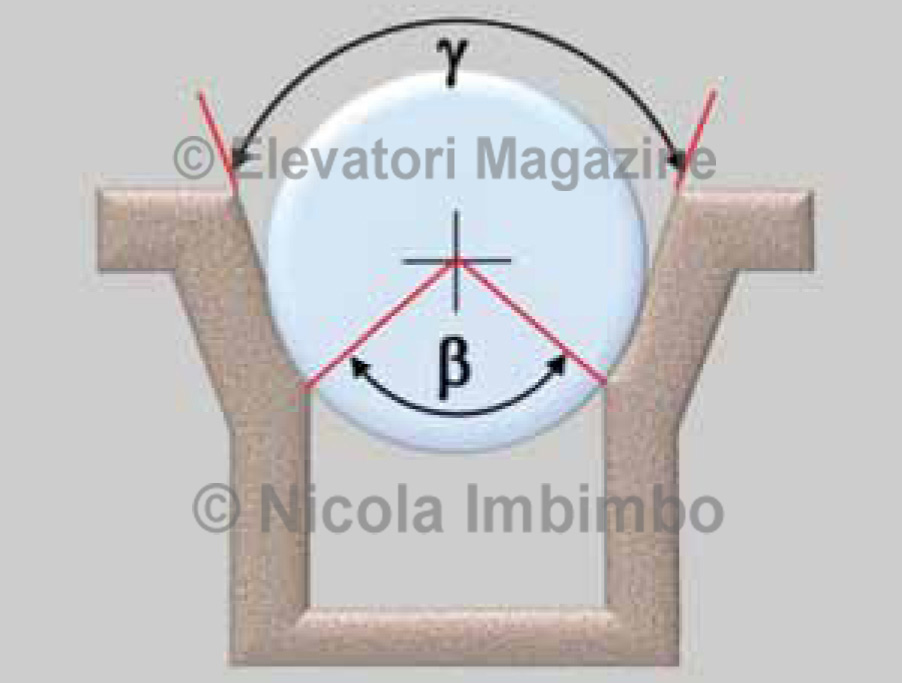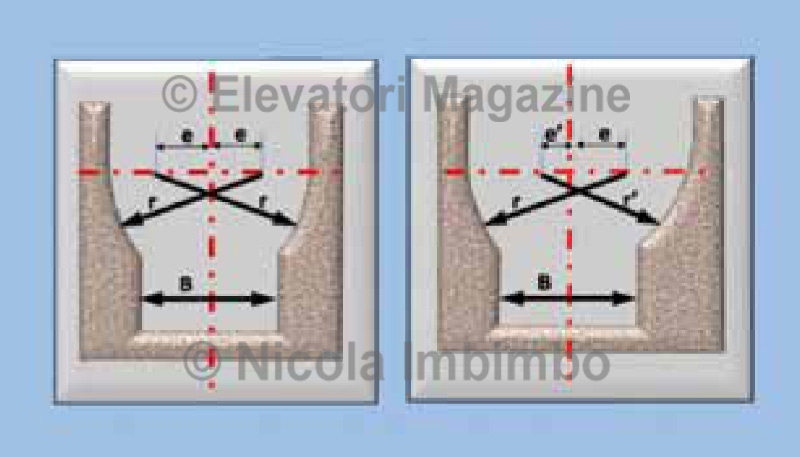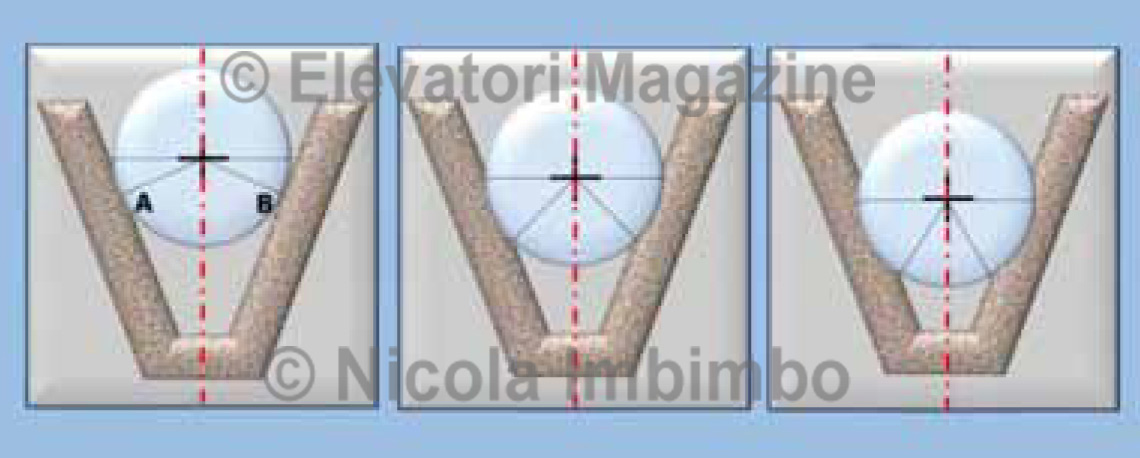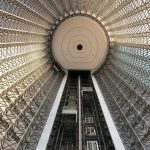Rope/sheave contact wear: a fine tuning – Part 2
By Nicola Imbimbo – Read the author’s biography
Articolo apparso la prima volta su Elevatori n. 4/2009
Rope/sheave contact wear: a fine tuning – Part 2 (click here to read the first part)
5. Traction Groove
It is generally accepted that the friction groove is the element required to transmit the movement between the motor and the traction rope, but at the same time it is also the element that guarantees that a sufficient tractive force be developed between the sheave and the rope: depending on the geometric shape (V or U with or without undercut), on the constructional angles (g and b) and on the wearing state.
A study was conducted in the 70s by Petkov [10] to check the real shape of U-undercut friction groove.

Figure 14 – V-Undercut Friction Groove: geometric parameter

Figure 15 – Real shape of “U-Undercut” friction groove
Over 300 measurements were taken from elevators in service.
What has been found is that: during the first period of service the groove shape change quickly and after that the diameter of the sheave is reduced, but more or less the shape remains almost the same.
All grooves shape inspected were more or less symmetrical, and their side profiles were more ellipses and hyperboles instead of circles as is mentioned in literature for friction calculation.
5.1 How wear affects the friction transmission
Even little changes in the original geometrical parameter could affect the friction performance, for this reason great care must be devoted to the maintenance in service of such element with periodical inspections, to check on a regular basis the amount of wear that develops [6,8].
In the relationship between rope and sheave, both of them are subject to wear during their use, but the rope wear is lesser compared to the sheave wear due to the following reasons: the rope is the hardest element and during one trip of the lift, one given point of the rope comes into contact with the traction sheave only once, but a point on the sheave comes in contact with the rope once each revolution. The design stage requires that the rope, considered as a “round” element, touch the traction sheave at the point indicated with A and B in the Figure 16.

Figure 16 – Wearing process into “V” and “V-Undercut” friction
During the time the wear on the surface will change the geometrical contact points, and the rope will re-groove itself a more rounded surface: this phenomenon will reduce the pinching effect and consequently there will be a loss of traction. A certain point will be reached due to the continuous starting and stopping of the lift will cause the ropes to begin to slip. When this happen and is clearly detected, then replacement or a re-grooving operation of the traction sheave, to restore the original condition of traction must take place [6,9].
Some study conducted by Molkow [9] in the IFT Institute of Stuttgart University, demonstrated that a well lubricated rope will develop better traction conditions: when the rope is in a well lubricated state, it will be fit better into the traction sheave and from such good contact will develop a higher apparent friction coefficient. This means that if after replacement of old ropes the new ones display some slips, this would mainly be related to the condition of the friction groove being worn by the old dry ropes and the only cure is to replace or re-cut the grooves to suit the new nominal rope diameter.
Very rare are the cases that this effect is generated by ropes that have their original lubrication maintained. A paper has been published by Major [13] dealing with the subject of rope re-lubrication in service.
8. Notes
The aim of this paper was mainly to go back to the basics on the main parameter affecting the lifetime of ropes and sheaves.
In practical terms it has been a good opportunity to offer this dissertation with simple and understandable topics in a way to allow the widest audience to understand it.
For sure it has not been the intention to offer a comprehensive discussion and in some cases the advice of an expert has to be sought. Most of the hints described in this paper have come from practical experience and are intended to offer a cross reference of thinking within the industry and not be classed as a directive.
Bibliographic references
[1] EN 81, Safety rule for the construction and installation of lifts and service lifts, Part I, Electric Lifts, Edition 2, European Standard, Brussels, 1985.
[2] EN 81-1/1998, Safety rules for the construction and installation of lifts, Part I: Electric Lifts.
[3] EN 12385-5:2003, Steel wire rope safety – Part 5: Stranded ropes for lifts.
[4] ISO 4309:2004, Cranes-Wire rope-Care, maintenance, installation examination and discard.
[5] Hymans, F./Hellbronn, A.V., Der neuzeitliche Aufzug mit Treibscheibenantrieb, Springer Verlag, Berlin 1927 (The modern elevator with traction drive).
[6] Hymans, F., Electric Elevators books I &II, International Textbook Company, Scranton PA. 1931.
[7] Paolelli, R., Ascensori e montacarichi ad azionamento elettrico,Collana di studi e documenti sulla prevenzione No.49, ENPI, Roma 1969 (Electric lifts for passengers and freight).
[8] Molkow, M., Wire ropes in elevators, Pfeifer Drako brochure, Mulheim an der Rhur 2002.
[9] Molkow, M., Driving capability of traction drives, Technical Bullettin No.5, Elevator World, Mobile AL.
[10] Petkov, K.D., Theoretical and experimental study of sheave and rope traction drive, International Lift Symposium, Amsterdam 1984.
[11] Janovsky, L., Elevator mechanical design Third Edition, Elevator World, Mobile Al. 1999.
[12] Scheunemann, W./Vogel, W./Barthel,T., Steel wire ropes in elevators, PFEIFER DRAKO brochure, Mulheim an der Rhur 2008.
[13] Major, D., Lubrication and maintenance of steel wire ropes on lifts, Elevation magazine, Dartford Kent 2008.
[14] Verrett, R., Negative impressions of the rope’s surface in the grooves of sheaves and drums, Wire Rope Technology brochure, Aachen 2006.
[15] Usabiaga, H./Madoz, M.A./Ezkurra, M./Pagalday, J.M., Mechanical interaction between wire ropes and sheaves, OIPEEC Conference “Trends for ropes”, Athens 2006.
[16] Urchegui, M.A./Madoz, M.A./Tato, W./Gomez, X., Wear characterisation techniques for fatigued wire ropes, OIPEEC Conference “Trends for ropes”, Athens 2006.
[17] Schonherr, S./Wehking, K.H., Reduction in service life of wire ropes running over sheaves with angular offset, OIPEEC Conference “Trends for ropes”, Athens 2006.
[18] Imbimbo, N., “Teoria e Pratica: Il controllo delle funi metalliche di sospensione”, Elevatori, n. 6/2005, pag. 68, Milano 2005 (clicca qui per leggerlo inline).
[19] Imbimbo, N., “Nuove tendenze per gli MRL”, Elevatori, n. 2/2007, pag. 50, Milano 2007.
The end








